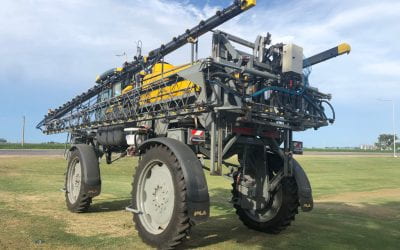Açaí and Beyond
Sustainability, Extension and Community Action
We are part of an agro-socio-biodiversity that connects human and non-human lives. Natural ecosystems, culture and different ways of being connect and sustain the lives of the Amazonian peoples. We understand that sustainability—reflected in both new and traditional crops— is built on the ancestry that exists in each territory.
Indeed, the recognition of this diversity has led to the regional production of the top-quality açaí in the world. Açaí, for those of you who may not be familiar with this dark purple Brazilian fruit, grows on native palm trees and has long been used by the Amazonian people. The increased export popularity of this crop in turn guarantees sustainable forest management because of lack of incentive to cut down trees.
University extension—our dream and passion—has played an integral part in this process. University can be a dream for those who want to get in, but it can be invisible to people for whom higher education has never been possible, attainable or allowed. We aim to make the university an open space for those historically neglected by society and bring them in to build new knowledge with us, especially in the areas of agriculture and sustainability.
Three years after the beginning of our work, in a post-pandemic period, Geová Alves, a Macedônia community resident, requested a meeting, “… [W]e are going to start a new project and we need you.” We looked at each other, smiled and realized at that moment that the seed we had planted with our extension outreach had already begun to sprout and grow.
Alves represents riverside families belonging to the Association of Traditional Communities of Bailique (ACTB) in Macedônia, in the island region of Bailique archipelago, where the Amazon River meets the sea. He is also the current treasurer of Amazonbai, a cooperative of about 200 açaí producers here in Amapá, created with the intention of producing quality açaí. certified and produced with socio-environmental safeguards. This cooperative achieved the first certification for the guarantee of sustainable forest management by the Forest Stewardship Council (FSC®) for açaí in the world. In December 2022, the project achieved organic product certification. In addition to the productive vision of the process, the increase in the community’s income goes to an educational fund for the family school, which aims to reduce the rural exodus. The project makes it more feasible to make a living through agriculture and strengthens the community-based economy.
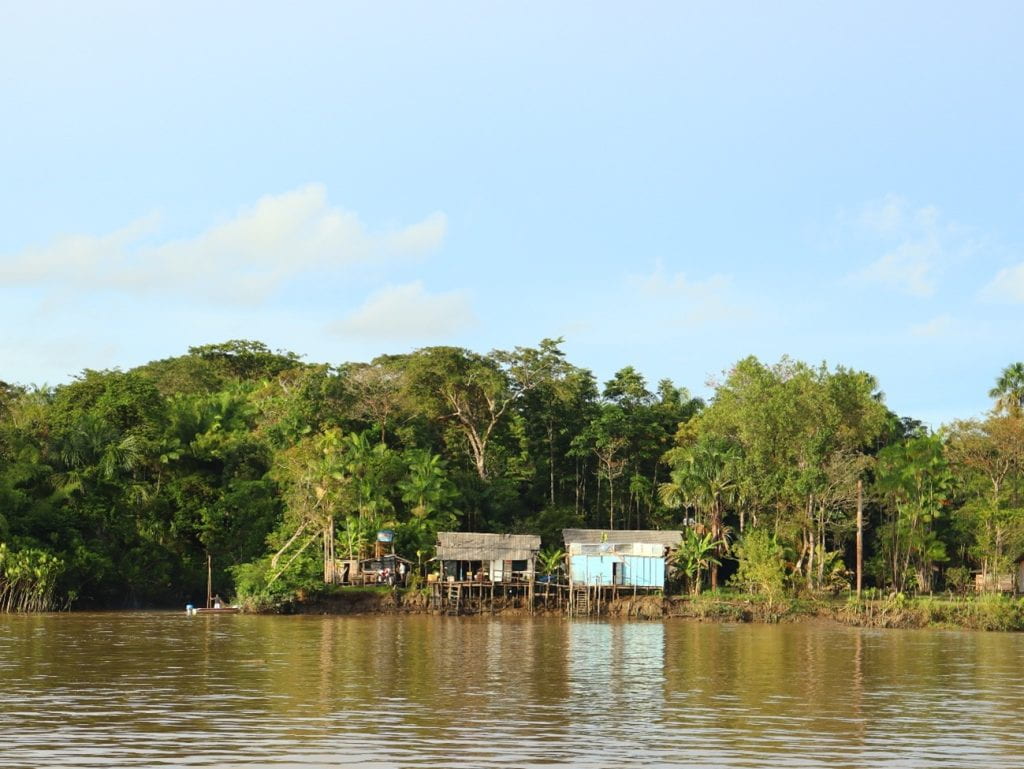
Village on the island of Curuá, in the Bailique archipelago at the mouth of the Amazon River, Amapá, Brazilian Amazon. Registration made on June 5, 2022, on the way to activities in the community of Limão do Curuá to support the implementation of the Bailique Family School.
Both certifications emerge from Bailique’s community protocol, developed by the Association of Traditional Communities of Bailique (ACTB) according to a case study by Manuela Agostini and Roberta Ramos. The authors point out that community protocols are initiatives supported by Convention 169 of the International Labor Organization (ILO), which seek to protect territories occupied by traditional populations through the creation of community agreements and governance instruments.
In Bailique, this process began in 2013, when social and economic empowerment mechanisms were developed to guarantee new forms of income, education and sustainable protection of the territory. Açaí cultivation was a big part of this story.
The cooperative members involved in the açaí business for Amazonbai live on the banks of the world’s largest river, both in terms of its length and volume of water—”the majestic Amazon River” and believe in unity and work for the common good. Although açaí is considered our “black gold.” The creation of the cooperative was never premised on the accumulation of wealth, but rather to tell the world that the cooperative members were tired of being neglected. They wanted a fair price, the guarantee of employment/income and improvements in people’s lives and the development of their territories. Thus, açaí is not only a community-based business, but it empowers and values the identity of peoples of the rivers and the forest and guarantees the livelihood of families.
Perhaps the way we are describing the construction of the Amazonbai cooperative and the viewpoint of those who live on the banks of the river can lead one to imagine that this is a fairy tale with everything perfect and harmonious, but it is not quite like that… We can start by talking about the difficulties in managing and removing the açaí fruit, which usually occurs within floodplain forests, in a forest environment. The removal of the fruit is done manually, at the top of the palm trees, which are on average 65 feet high, so very young children, young people and limber adults climb the trees risking their lives with a machete, a peconha (traditional rope tied to the feet for support) and the strength of their legs. The peconheiro, the person who climbs the açaí tree, generally receives half the product collected as payment for their services.
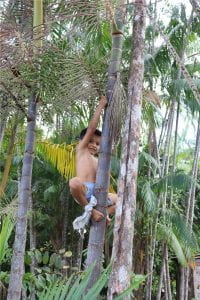
Pietro Barbosa climbing on an açaí tree. Pietro is the son of Pedro Barbosa, they are residents of the community of São João Batista in Bailique. Pedro is an extractivist and cooperative member of Amazonbai and an active participant in the activities we carry out in the territory. Record made on July 9, 2021 during the break of the socio-environmental cartography workshop in the community of São João Batista.
After the açaí harvest, there are other challenges such as the flow of production. A middleman, a merchant who arrives in the community to buy açaí at below-market prices and pays in cash, shows up. For residents, this provides an alternative to traveling to Macapá, the state capital, since the trip is costly, and part of the harvest can be lost because of transport conditions.
The price paid to the peconheiro (who actually climbs the açaí tree), the ease of payment and the logistics of delivering the product are other variables that influence production. Most area families have been managing açaí trees for generations and derive their livelihood from it, both in relation to sale and self-consumption.
Amazonbai, an organization with the capacity to organize, logistically and financially, collects the produce, passing on a socially fair value in a timely manner to its producers. We remind you that the certifications sought by the cooperative make up the rules for access to the expanding market of the açaí production chain, but in addition, the management of açaí trees has been done by these peoples for generations. This way of living with the forest has attracted the eyes of several world actors interested in low-impact production models, that are capable of mitigating climate change and promoting sustainable development. In this sense, keeping the forest standing is a basic condition for the subsistence of local populations.
The Role of Extension
At the beginning of the process, in 2019, we signed a series of cooperation agreements between the university and non-governmental organizations, including ACTB and Amazonbai. We focused on two processes: the notion of a popular education and participatory community planning; which would integrate this mosaic of lives, like a dreamcatcher, having in common the sustainability of life.
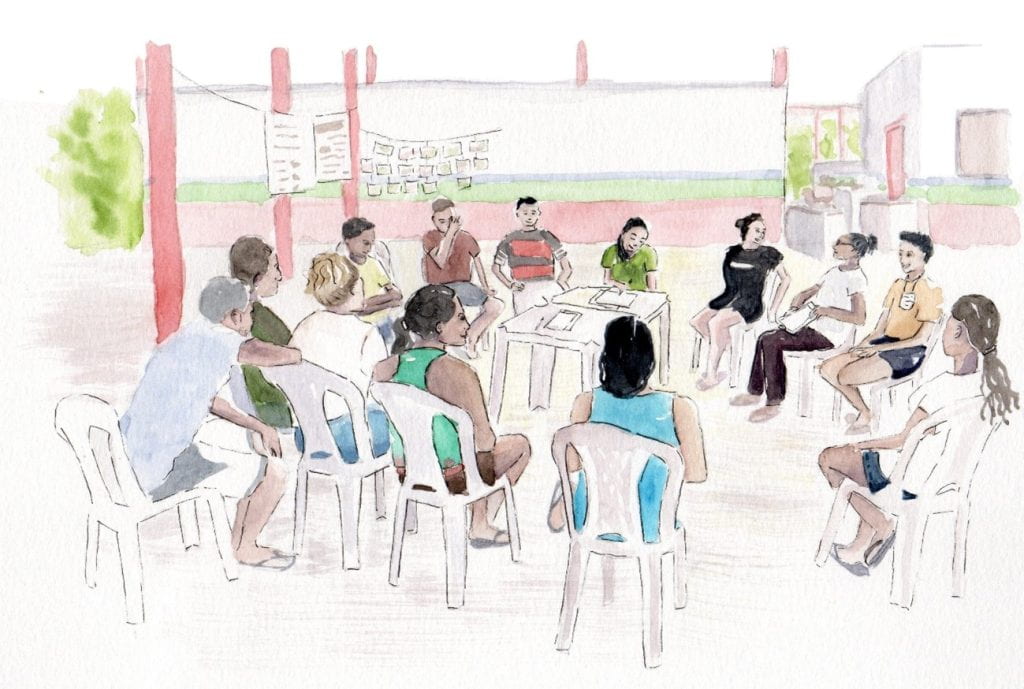
Watercolor representing the countless encounters that have been taking place throughout the process of interaction between the university and riverside communities in Amapá. Watercolor by Luana Rocha, courtesy of the artist.
We aimed to understand the main possibilities and challenges in each territory. Once we figured out what was needed, we could direct research and extension efforts. Listening became the protagonist, dialogues were built and horizontal relationships were woven.
The traditional Amazonian riverine peoples live by working, producing cooperative and diversified practices of use and occupation of the territory. The diversity of their work—depending on the multiple possibilities of subsistence that the Amazonian territories provide—is one of the main characteristics of the riverside people. “I take açaí from the forest, but when it’s not in season, I fish; and if there are no fish, I plant; and if it is not harvesting time, I hunt; And if there’s no game, I’ll go to açaí…”
When we look at the community-based economy of the Amazonian territories in Amapá where we operate, we find that the açaí production chain plays a fundamental role both in the economy and in the food security of families. So we turn our gaze to the residues of the açaí seed, which in general are a problem, as they do not have their own destination.
Then, we realized that our actions needed to identify destinations for açaí waste, based on local possibilities, considering the real needs in the productive practice of the community members. Some of the priorities we identified were the production of organic fertilizer for agriculture; new products that did not require high costs to be elaborated, such as potted plants, pot rests, decorative spheres and decorative plates, adding value to the production chain, and consequently, employment and income for the families there.
Over time, we also recorded the challenges that traditional communities face in the territories, including the lack of access to basic rights, such as potable water, basic sanitation, energy, maintenance of access roads to homes (walkways on stilts), garbage collection and access to communication. Even so, organized groups to achieve improvements in the quality of life. We observed that in this process of community organization, the spatial-temporal discussion of the territory, in a context of participatory territorial planning, was fundamental for the development of traditional communities from within, and consequently, amplification of their practices in a regional context.
Resistance—perhaps re-existence—are attitudes often identified in the social relations that the traditional peoples of the Amazons establish among themselves and with other peoples, demonstrated by the sustainability of their existence with their ways of life. We chose participatory methodologies to consider complex relationships among the riverine communities because we understood the need for co-production of what we were doing and the sharing of power, in the search to generate an environment of equality. Along the way, we challenged our partners to tell their stories through drawings, maps, theaters, music, sculptures and narratives that found the sounds and tales of rivers, forests, tides and the land. This process inevitably awakened the sense of belonging that is established between communities and Mother Earth.
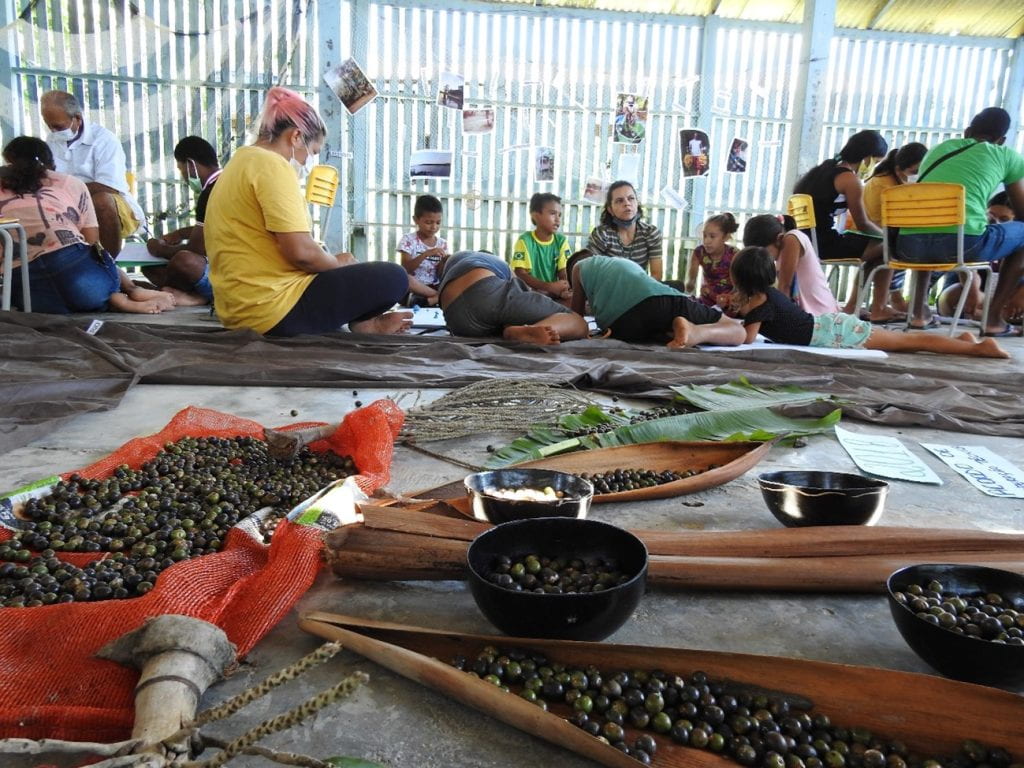
Activity to build socio-environmental cartography in the communities of South Bailique, held on October 8, 2021. In the image, representations of the participants’ lives and the use of participatory methodologies.
The use of these strategies reminds us of the need to include resident farmers, riverside dwellers and harvesters who are not necessarily educated. Agriculture appeared throughout this process as an ancestral activity, of a living culture, in which the food produced on the land not only represents work, but also the food and joy of the people who inhabit these spaces. Thus, we understand that community members experience well-being as guardians of the forest, the river and the land. They see in family-based agriculture the hope of leaving behind the invisibility of their work, recognizing that their products reach our tables—such as the cassava flour, tucupi, tapioca and açaí that are part of the food culture of the peoples of the Amazon.
Thus, we need to develop new development alternatives for the Amazon, which must take into account at least five pillars: respect for the identity of the peoples and the cultural differences between the various peoples of the region, the use of social practices and secular knowledge built on the region by its inhabitants, respect for nature, the use of its mega-biodiversity and the increasing investment in applied science directed to regional interests.
Thanks to the steps taken by the extension program, Geová Alves, already closely allied with university extension, sent us the message at the beginning of this story. Alves’ message reverberates to this day in our daily lives because, there, we realized that we had succeeded. Traditional riverside populations, invisible to the state and the public authorities, understood that they were welcome at our university, which for many was the beginning of hope. More than a hundred of their sons, daughters, and relatives are now university students and are part of research and extension projects.
On that day, Alves explained to us that the ACTB had approved a project with a supporter and that it would revisit the community protocol in the communities of Bailique and needed help in building an interesting methodology. We then understood the concept of total citizen control described by Sherry Arnstein, in which participation is consolidated by the action of the social group. The institutional mission of this new university is no longer restricted to the classic teaching/research/extension tripod but expands as it allows the exercise of power by subaltern groups, in the hope of building a less unequal Amazonian society, reflected in the diversity of its agricultural production and byproducts.
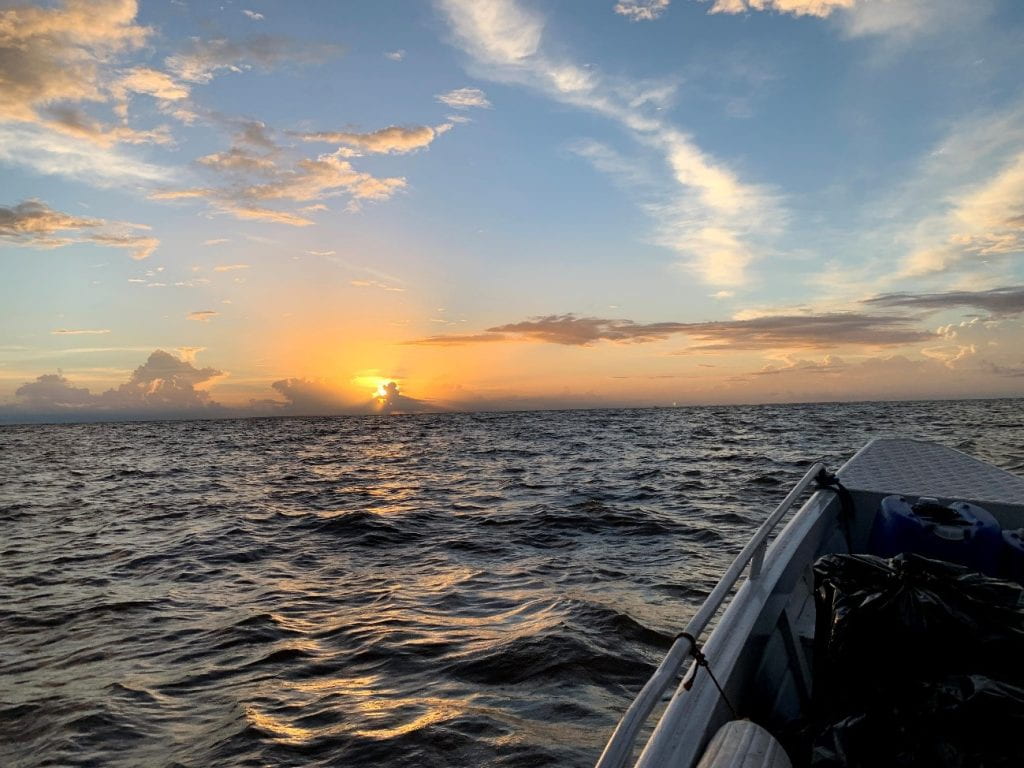
Sunset at the mouth of the Amazon River on the return trip from Balique on July 11, 2021 after university actions in the territory. A vision of hope.
Kelly Gomes, Janaina Calado and Katia Paulino are mothers and teachers, born in the Amazon and with a common dream, to improve people’s lives through an emancipatory educational process, making us small artisans in the construction of a fairer and more sustainable world. Gomes is a pedagogue with a doctorate in education, Calado is a biologist with a doctorate in ecology, and Paulino is a sociologist with a doctorate in management. Amongst the boats, salty sea breeze, hammocks and the wooden floor of the riverside territories, we enhance our extension and research practices through critical and emancipatory socio-environmental education.
Açaí e muito mais
Sustentabilidade, Extensão e Ação Comunitária
Por Raimunda Kelly Silva Gomes, Janaina Freitas Calado e Kátia Paulino dos Santos
Somos parte de uma agro-socio-biodiversidade que conecta as vidas humanas e não humanas. Ecossistemas naturais, cultura e diferentes formas de estar conectam e sustentam a vida dos povos amazônicos. Entendemos que a sustentabilidade – refletida tanto em culturas novas quanto tradicionais– é construída a partir da ancestralidade que existe em cada território.
De fato, o reconhecimento dessa diversidade levou à produção regional do açaí de melhor qualidade do mundo. Açaí, para quem não conhece essa fruta roxa escura brasileira, cresce em palmeiras nativas e há muito tempo é usada pelos povos amazônicos. O aumento da popularidade de exportação desta cultura, por sua vez, garante o manejo florestal sustentável devido à falta de incentivo ao corte de árvores.
Extensão universitária – nosso sonho e paixão – tem desempenhado um papel fundamental nesse processo. A universidade pode ser um sonho para quem deseja entrar, mas pode ser invisível para pessoas às quais o ensino superior nunca foi possível, alcançável ou permitido. Nós buscamos fazer da universidade um espaço aberto para aqueles historicamente negligenciados pela sociedade e trazê-los para construir novos conhecimentos conosco, especialmente nas áreas de agricultura e sustentabilidade.
Três anos depois do início do nosso trabalho, em um período pós-pandêmico, Geová Alves, morador da comunidade de Macedônia, solicitou uma reunião, “… Precisamos marcar uma reunião pois iniciaremos um novo projeto e precisamos de vocês.” Nos entreolhamos, sorrimos, e percebemos naquela hora que a semente plantada com nossa extensão já brotava e crescia.

Geová Alves, morador da comunidade de Macedônia, presidente da Associação das Comunidades Tradicionais do Bailique e cooperado da Cooperativa dos Produtores Agroextrativistas do Bailique e do Beira Amazonas. Registro no dia 05 de março de 2021 na reunião de planejamento das atividades anual na Universidade do Estado do Amapá.
Alves representa famílias ribeirinhas pertencentes à Associação das Comunidades Tradicionais do Bailique (ACTB) em Macedônia, na região insular do arquipélago do Bailique, onde o rio Amazonas encontra o mar. Ele também é o atual tesoureiro da Amazonbai, uma cooperativa de cerca de 200 produtores de açaí aqui no Amapá, que nasceu com a intenção de produzir açaí de qualidade, certificado e produzido com salvaguardas socioambientais. Esta cooperativa conquistou a primeira certificação para o garante do manejo florestal sustentável pelo Conselho de Manejo Florestal (FSC®) para o açaí no mundo. Em dezembro de 2022, o projeto conquistou a certificação de produto orgânico. Para além da visão produtiva do processo, o incremento de renda da comunidade vai para um fundo educacional para a escola família, que visa diminuição do êxodo rural. O projeto torna mais viável viver da agricultura e fortalece a economia de base comunitária.

Vilarejo na ilha do Curuá, no arquipélago do Bailique na foz do rio Amazonas, Amapá, Amazônia brasileira. Registro realizado dia 05 de junho de 2022, a caminho de atividades na comunidade do Limão do Curuá para apoio a implementação da Escola Família do Bailique.
Ambas as certificações emergem do protocolo comunitário de Bailique, desenvolvido pela Associação das Comunidades Tradicionais do Bailique (ACTB) de acordo com um estudo de caso realizado por Manuela Agostini e Roberta Ramos. As autoras destacam que os protocolos comunitários são iniciativas amparadas pela convenção 169 da Organização Internacional do Trabalho (OIT), que buscam proteger territórios ocupados por populações tradicionais através da criação de acordos comunitários e de instrumentos de governança.
Em Bailique, esse processo iniciou em 2013, quando foram desenvolvidos mecanismos de empoderamento social e econômico para garantir novas formas de renda, educação e proteção sustentável do território. O cultivo do açaí foi uma grande parte dessa história.
Os cooperados envolvidos no negócio do açaí para o Amazonbai vivem às margens do maior rio do mundo, tanto em extensão quanto em volume de água – “o majestoso rio Amazonas” e acreditam na união e no trabalho pelo bem comum. Embora o açaí seja considerado o nosso “ouro preto”, a criação da cooperativa nunca teve como premissa a acumulação de riquezas, mas sim dizer ao mundo que os cooperados estavam cansados de serem negligenciados. Queriam um preço justo, a garantia de emprego/renda e melhorias na vida das pessoas e no desenvolvimento de seus territórios. Assim, o açaí não é apenas um negócio de base comunitária, mas empodera e valoriza a identidade dos povos dos rios e da floresta e garante o sustento das famílias.
Talvez a forma como colocamos a construção da cooperativa Amazonbai e o olhar de quem vive as margens do rio, leve a imaginar que estamos num conto de fadas com tudo perfeito e harmônico, mas não é bem assim… Podemos começar falando das dificuldades para o manejo e retirada do fruto do açaí, que normalmente ocorre dentro das florestas de várzea, em um ambiente de mata. A retirada do fruto é feita manualmente, no alto das palmeiras, que possuem em média 20 metros de altura, por isso, crianças, jovens e adultos muito pequenos sobem nas árvores arriscando a vida com um facão, uma peconha (um amarrado nos pés para sustentação) e a força das pernas. O peconheiro, pessoa que sobe no açaizeiro, geralmente recebe metade do produto arrecadado como pagamento por seus serviços.

Pietro Barbosa climbing on an açaí tree. Pietro is the son of Pedro Barbosa, they are residents of the community of São João Batista in Bailique. Pedro is an extractivist and cooperative member of Amazonbai and an active participant in the activities we carry out in the territory. Record made on July 9, 2021 during the break of the socio-environmental cartography workshop in the community of São João Batista.
Depois da colheita do açaí, há outros desafios, como o escoamento da produção. Um atravessador, um comerciante que chega na comunidade para comprar açaí a preços abaixo do mercado e paga em espécie, aparece. Para os moradores, isso oferece uma alternativa ao deslocamento até Macapá, capital do estado, já que a viagem é cara e parte da colheita pode ser perdida por causa das condições de transporte.
O preço pago ao peconheiro (que realmente sobe no açaí), a facilidade de pagamento e a logística de entrega do produto são outras variáveis que influenciam na produção. A maioria das famílias da região maneja o açaí há gerações e dele tira seu sustento, tanto em relação à venda quanto ao autoconsumo.
A Amazonbai, organização com capacidade de organizar, logística e financeiramente, recolhe os produtos, repassando um valor socialmente justo em tempo adequado aos seus produtores. Lembramos que as certificações almejadas pela cooperativa compõem as regras de acesso ao mercado em expansão da cadeia produtiva do açaí, mas para além disso, o manejo de açaizais é feito por esses povos há gerações. Essa forma de conviver com a floresta tem atraído olhares de diversos atores mundiais interessados em modelos produtivos de baixo impacto, capazes de mitigar as mudanças climáticas e promover o desenvolvimento sustentável. Neste sentido, manter a floresta em pé é condição básica para a subsistência das populações locais.
O papel da extensão
Ainda no início do processo, em 2019, celebramos uma série de acordos de cooperação entre a universidade e organizações não- governamentais, dentre elas a ACTB e a Amazonbai. Focamos em dois processos: a noção de uma educação popular e um planejamento comunitário participativo, que integrasse esse mosaico de vidas, como um apanhador de sonhos, (dreamcatcher) que têm em comum a sustentabilidade da vida.

Aquarela representando os inúmeros encontros que vem ocorrendo ao longo do processo de interação entre universidade e comunidades ribeirinhas do Amapá. Aquarela de Luana Rocha, com autorização do uso.
Buscamos compreender as principais possibilidades e desafios em cada território. Uma vez descoberto o que era necessário, pudemos direcionar esforços de pesquisa e extensão. O escutar tornou-se protagonista, diálogos foram construídos e relações horizontais foram tecidas.
Os povos tradicionais ribeirinhos amazônicos vivem trabalhando, produzindo práticas cooperativas e diversificadas de uso e ocupação do território. A diversidade do seu trabalho – a depender das múltiplas possibilidades de subsistência que os territórios amazônicos proporcionam – é uma das principais características do povo ribeirinho. “Eu tiro açaí da floresta, mas quando não está na safra, eu pesco; e se não tem peixe, eu planto; e se não está na época da colheita, eu caço; e se não tem caça, eu vou pro açaí…”
Ao olharmos para a economia de base comunitária dos territórios amazônicos amapaenses em que atuamos, verificamos que a cadeia produtiva do açaí assume um papel fundamental tanto na econômica, como na segurança alimentar das famílias. Então direcionamos nosso olhar para os resíduos do caroço do açaí, que em geral são uma problemática, pois não possuem uma destinação própria.
Então, percebemos que nossas ações precisavam identificar destinações dos resíduos do açaí, a partir das possibilidades locais, considerando as reais necessidades na prática produtiva dos comunitários. Algumas das prioridades que identificamos foram a produção de adubo orgânico para a agricultura; novos produtos que não precisassem de altos custos para serem elaborados, a exemplo: vasos de plantas, descanso para panelas, esferas decorativas e placas decorativas, agregando valor a cadeia produtiva, e, consequentemente, emprego e renda às famílias ali existentes.
Ao longo do tempo, registramos ainda os desafios que as comunidades tradicionais enfrentam nos territórios, entre eles a falta de acesso a direitos básicos, como água potável, saneamento básico, energia, falta de manutenção das vias de acesso às casas (passarelas sobre palafitas), coleta de lixo e acesso à comunicação. Mesmo assim, eles organizaram grupos para alcançar melhorias na qualidade de vida. Observamos que, nesse processo de organização comunitária, a discussão espaço-temporal do território, em um contexto de planejamento territorial participativo, foi fundamental para o desenvolvimento interno das comunidades tradicionais e, consequentemente, ampliação de suas práticas em um contexto regional.
Resistência – talvez re-existência – são atitudes frequentemente identificadas nas relações sociais que os povos tradicionais da Amazônia estabelecem entre si e com os outros povos, demonstrado pela sustentabilidade de sua existência com seus modos de vida. Optamos por metodologias participativas para considerar as relações complexas entre as comunidades ribeirinhas por entendermos a necessidade de coprodução do que estávamos fazendo e de compartilhamento de poder, na busca de gerar um ambiente de igualdade. Nesse caminho, desafiamos nossos parceiros a contarem suas histórias por desenhos, mapas, teatros, músicas, esculturas e por narrativas que achavam nos sons e contos dos rios, das florestas, das marés e da terra. Esse processo inevitavelmente despertou o sentimento de pertencimento que se estabelece entre as comunidades e a Mãe Terra.

Atividade de construção da cartografia socioambiental nas comunidades do Sul do Bailique, realizada no dia 08 de outubro de 2021. Na imagem, há representações da vida dos participantes e o uso de metodologias participativas.
O uso dessas estratégias nos remente à necessidade de inclusão dos agricultores residentes, ribeirinhos e colheitadeiras que não tem necessariamente educação formal. A agricultura apareceu ao longo desse processo como uma atividade ancestral, de uma cultura viva, em que os alimentos produzidos na terra, não representa apenas o trabalho, mas também, o alimento e a alegria das pessoas que habitam esses espaços. Assim, entendemos que os membros da comunidade vivenciam o bem-estar como guardiões da floresta, do rio e da terra. Eles veem na agricultura familiar a esperança de deixar para trás a invisibilidade de seu trabalho, reconhecendo que seus produtos chegam às nossas mesas – como a farinha de mandioca, o tucupi, tapioca, o açaí e tantos outros que fazem parte da cultura alimentar dos povos da Amazônia.
Assim, precisamos desenvolver novas alternativas de desenvolvimento para a Amazônia, que devem levar em conta pelo menos cinco pilares: o respeito à identidade dos povos e à diferença cultural entre os diversos povos da região; o aproveitamento das práticas sociais e saberes seculares construídos sobre a região pelos seus habitantes; o respeito à natureza; o aproveitamento da sua mega biodiversidade; e o investimento cada vez maior em ciência aplicada e direcionada aos interesses regionais.
Graças ao percurso trilhado foi que Geová, já muito aliado à extensão universitária, nos mandou a mensagem do início deste relato. A mensagem de Alves reverbera até hoje no nosso dia a dia porque percebemos que conseguimos. Populações tradicionais ribeirinhas, invisíveis ao estado e ao poder público, compreendiam que eram bem-vindas na nossa universidade, que para muitos era o início de um esperançar. Mais de cem filhos, filhas e parentes daquelas pessoas agora são estudantes universitários e integram projetos de pesquisa e extensão.
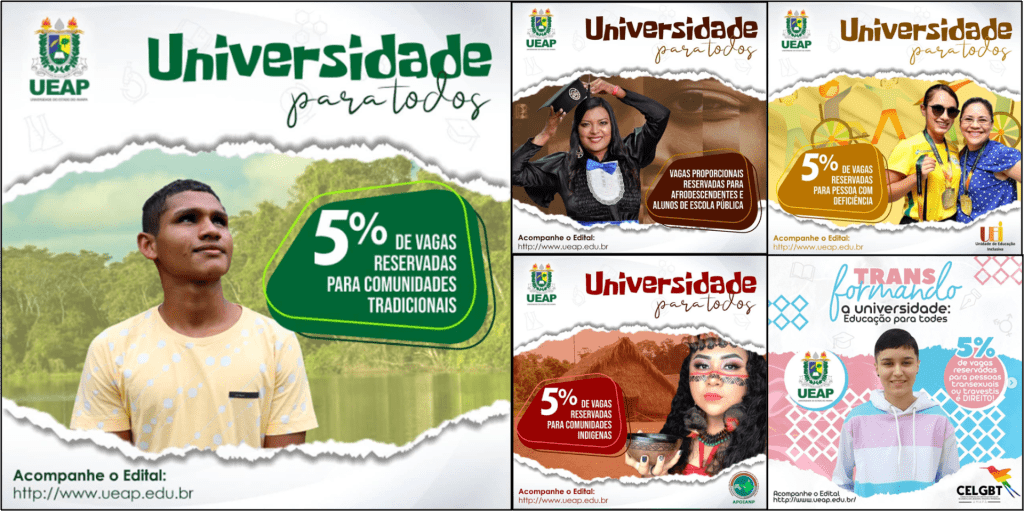
Resumo da política de cotas de Universidade do Estado do Amapá. Destaque para as cotas de comunidades tradicionais que é representada pelo aluno de matemática, Kleucivan Correia Mira, morador da comunidade do Carvão, Mazagão, ex-aluno da Escola Família Agroextrativista do Carvão.
Naquele dia, Alves nos explicou que a ACTB havia aprovado um projeto com um apoiador, que iria revisitar do protocolo comunitário nas comunidades de Bailique e precisava de ajuda na construção uma metodologia interessante. Compreendeu-se, então, o conceito de total controle cidadão descrito por Sherry Arnstein, no qual a participação se consolida através da ação do grupo social. A missão institucional dessa nova universidade já não se restringe ao clássico tripé ensino/pesquisa/extensão, mas se amplia à medida que permite o exercício de poder de grupos subalternizados, na esperança da construção de uma sociedade amazônica menos desigual, refletida na diversidade de seus produtos e derivados agrícolas.

Pôr do sol na foz do rio Amazonas na viagem de volta do Balique no dia 11 de julho de 2021 após ações da universidade no território. Uma visão de esperança.
Kelly Gomes, Janaina Calado e Kátia Paulino são mães e professoras, nascidas na Amazônia e com um sonho em comum, de melhorar a vida das pessoas através de um processo educativo emancipatório, se tornando pequenas artesãs na construção de um mundo mais justo e sustentável. Gomes é pedagoga com doutorado em educação, Calado é bióloga com doutorado em ecologia e Paulino é socióloga com doutorado em administração. Entre barcos, brisa salgada do mar, redes e o chão de madeira dos territórios ribeirinhos, potencializamos nossas práticas de extensão e pesquisa por meio da educação socioambiental crítica e emancipatória.
Related Articles
Editor’s Letter: Agriculture and the Rural Environment
From agribusiness to climate change to new alternative crops, agriculture faces an evolving panorama in Latin America and the Caribbean.
Local “sweetening” of the Cocoa Commodity? Alternative Economies in the Peruvian Amazon
The road was nearly impassable again because of the rain.
Agro-technological Revolutions in Latin America
When we speak about a revolution in agriculture in Latin American history, most scholars rightly think of peasant revolts, land tenure struggles or commodification of crops, to name a few of the most salient themes.


